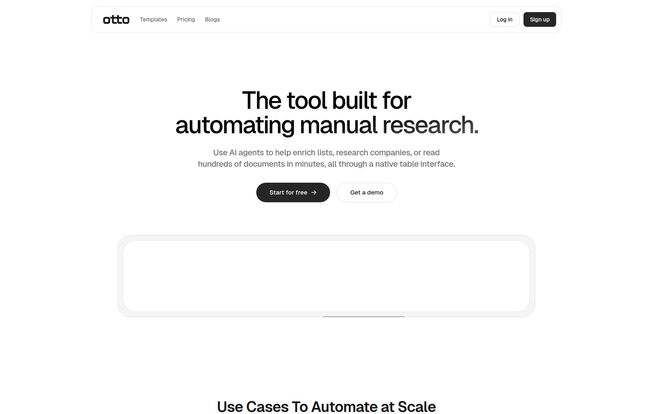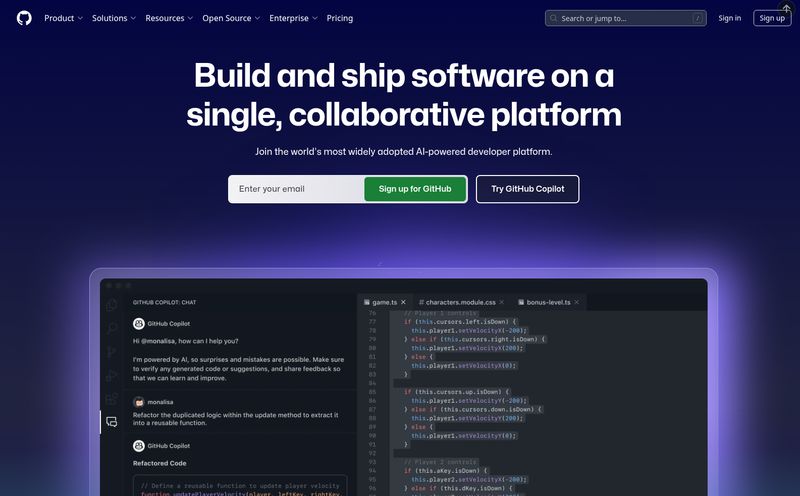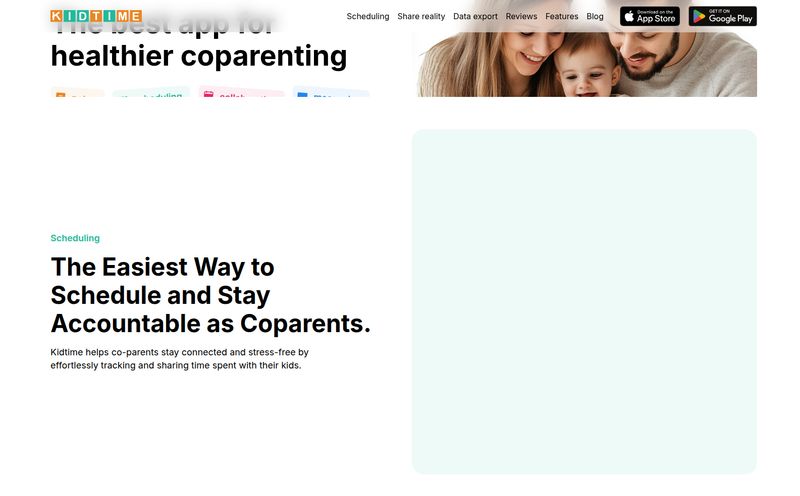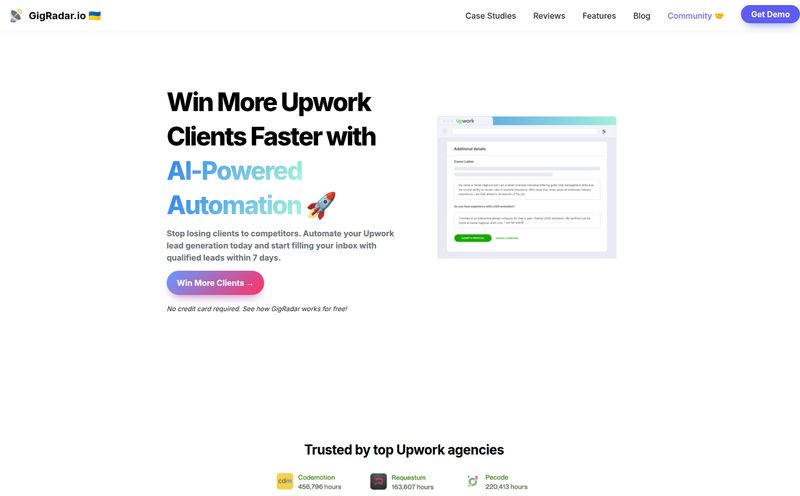If you've ever worked in sales, marketing, recruiting, or frankly, any job that requires knowing things about other things, you've felt the pain. The slow, soul-crushing pain of manual research. That endless cycle of copy-pasting from one browser tab to a spreadsheet. Finding websites. Hunting for social profiles. Trying to extract one tiny piece of information from a 50-page PDF. It's a grind. A necessary evil that eats up hours we could be spending on, you know, actual strategy and human connection.
For years, we've tried to MacGyver our way out of it with a patchwork of browser extensions, half-baked Zapier automations, and the occasional intern. But it always felt clunky. Well, I’ve been playing around with a tool called Otto, and I gotta say, it feels like we’re finally getting somewhere. It's one of those platforms that makes you stop and think, “Wait, it can do that?”
So, What Exactly is This Otto Thing?
At its core, Otto is an AI-powered platform built to put your manual research tasks on autopilot. Think of it as a team of incredibly fast, caffeine-fueled research assistants who live inside a spreadsheet. You give them a list of companies, a pile of documents, or a bunch of websites, and they go to work, enriching your data in minutes, not days.
The whole experience is built around a familiar table interface, so it doesn't feel like you’re learning some complex new software. You build a table, tell each column what information you want to find using its AI agents, and then you just… let it run. It's designed for doing this stuff at scale, turning what used to be a week-long project into an afternoon task.
Who Is Otto Built For?
While anyone who hates copy-pasting could find a use for it, Otto really sings for specific professionals. I can immediately see this being a game-changer for a few groups:
- Sales and Lead Generation Teams: Imagine uploading a list of 500 company names and having Otto automatically find their website, LinkedIn page, industry, and maybe even pull the first paragraph from their 'About Us' page. That's targeted outreach fuel right there.
- Marketers and SEOs: Doing competitor analysis? Researching potential backlink opportunities? You can use Otto to scrape websites for specific keywords, check for certain technologies on a site, or even summarize a competitor's latest blog posts. The potential for content research is huge.
- Recruiters: Sifting through hundreds of profiles or applications? You could use Otto to extract key skills, years of experience, or other specific data points from a pile of resumes in PDF format, helping you filter candidates way faster.
- Real Estate and Finance Folks: The website shows examples for pulling property data or financial details. Analyzing reports, listings, or market data becomes way less of a chore when an AI can do the heavy lifting of data extraction for you.
Basically, if your job involves a spreadsheet and more than five open browser tabs at any given time, you’re probably the target audience.

Visit Otto
My Favorite Otto Features Breakdown
Okay, let's get into the good stuff. There are a few features that really stood out to me during my testing.
The Easiest Web Scraper I’ve Ever Seen
I’ve used my fair share of web scraping tools, and they usually involve dealing with CSS selectors, XPaths, or some kind of visual point-and-click system that breaks if the website changes a pixel. Otto’s approach is… different. You just write what you want in plain English. For example, you can point it to a product page and literally type the prompt: “extract the price and the customer review rating.” That’s it. This is ridiculously powerful and lowers the barrier to entry for web scraping significantly. No more inspecting source code like you're in The Matrix.
Data Enrichment That Actually Works
This is the bread and butter. The ability to “enrich” a list is invaluable. You start with one piece of data, like a company name, and Otto can build out a whole profile. It has a library of pre-built enrichments for finding things like social media profiles, company descriptions, website URLs, and more. It’s like having a premium data service like Clearbit or ZoomInfo, but integrated directly into your workflow and on a more flexible credit basis. Its a fantastic way to turn a basic list into an actionable database.
Taming the Document Beast
This one feels like magic. We all get sent those massive PDFs—market reports, compliance documents, a batch of invoices—and are told to find the “important bits.” Otto lets you dump hundreds of these documents into its system and ask questions. For instance, you could upload 100 customer feedback forms and ask it to “Summarize the main complaint and categorize the feedback as 'Positive', 'Negative', or 'Neutral' for each document.” The time saved here isn't just incremental; it’s transformative.
Let's Talk Money: Otto’s Pricing Structure
Alright, the all-important question: what’s it going to cost? Pricing can make or break a tool like this, and Otto has a pretty flexible, tiered approach. It's primarily based on a credit system, where different actions cost a certain number of credits.
Here’s a quick look at their plans:
| Plan | Price | Best For | Key Details |
|---|---|---|---|
| Free | $0 / month | Individuals & Testers | 500 credits, can import CSVs, analyze PDFs/images. It's a genuinely useful free tier to see if it works for you. |
| Starter | $99 / month | Freelancers & Small Teams | 12,500 credits, a lot more concurrent processing, unlimited rows, and crucial integrations. This feels like the sweet spot for serious users. |
| Pro | $299 / month | Growing Businesses | 50,000 credits, premium integrations, support for up to 10 team members, and priority support. Plus, a 'CEO Phone number' feature which I am incredibly curious about. |
| Enterprise | Custom | Large Organizations | Unlimited everything, on-premise options, SAML support, and tailored solutions. The full white-glove treatment. |
What I appreciate is that the Free plan isn't just a teaser; 500 credits is enough to run a real test and see the value firsthand. You can also buy credit top-ups if you have a big project one month, which is a nice touch. For instance, an extra 2,000 credits will set you back $30.
The Real-World ROI with Otto
The pricing page has a neat little ROI calculator, which I love to see. It forces you to stop thinking about the monthly cost and start thinking about the value of your time. Let's say you value your time at a conservative $50/hour. If Otto saves you just 5 hours of manual drudgery a month—which, from my experience, seems very plausible—you're saving $250. Suddenly, that $99 Starter plan doesn't just pay for itself; it generates a positive return.
Time is the one resource we can’t get more of. Tools that give us some of it back are worth their weight in gold. For a sales team, what’s the value of 10 extra hours a month they can spend on calls instead of data entry? That’s where the real ROI is found.
Are There Any Downsides?
No tool is perfect, and it would be dishonest to pretend otherwise. From my perspective, there are a couple of things to keep in mind.
First, while the 'plain English' prompts are amazing, there's still a bit of a learning curve to what I'd call 'effective prompt engineering.' Learning how to ask the AI the right question to get the most accurate data will take some trial and error. You have to learn to speak its language a little bit.
Second, you're placing a lot of trust in the AI's accuracy. For mission-critical data, you'll probably want to have a human spot-check a sample of the results, at least initially. The AI is good, but it can misinterpret a weirdly formatted website or a messy PDF just like a human can. The quality of your output is dependant on the quality of the source data.
Finally, the jump from Free to the $99 Starter plan might be a bit steep for solo operators or those in developing countries, even with the clear ROI. It positions itself as a premium, professional tool, and the price reflects that.
Frequently Asked Questions about Otto
How does the credit system work?
Every task in Otto consumes a certain number of credits. Simple tasks like finding a website might cost just a few credits, while more complex ones like analyzing a large PDF with AI will cost more. The plans come with a monthly credit allowance, and you can top up if you run out.
Do the credits expire?
Based on their site, the monthly credits that come with your subscription reset each month. However, any flexible credit top-ups you purchase separately likely have a longer shelf life, which is a common practice for this model.
How accurate is the data extraction from Otto?
It's very accurate for well-structured data, but as with any AI, accuracy can vary depending on the complexity and quality of the source. For standard tasks like finding a LinkedIn URL from a company name, it's excellent. For extracting specific, nuanced text from a messy website, you should plan on a small margin of error and do some spot-checking.
Can Otto replace my entire research team?
Ha, not quite. It's more like a force multiplier. It automates the 80% of research that is repetitive and time-consuming, freeing up your human team to focus on the 20% that requires critical thinking, analysis, and building relationships. It makes your team more efficient, not obsolete.
Is Otto easy to get started with?
Yes, I'd say so. The table interface is very intuitive, feeling a lot like Google Sheets or Airtable. The main learning curve is in mastering the prompts for the AI agents, but the pre-built library gives you a massive head start.
My Final Thoughts on Otto
After spending some quality time with Otto, I'm genuinely impressed. It’s a slick, powerful, and surprisingly intuitive solution to a problem that has plagued professionals for decades. It’s not just another scraping tool; it’s a well-thought-out research automation platform.
If you're an individual or a team that finds itself constantly bogged down by the sheer volume of manual data gathering, you owe it to yourself to sign up for the free plan and give it a spin. Automate a small, annoying task you do every week. I have a feeling that once you see hours of work get done in minutes, you'll have a hard time going back to the old way of doing things. The robots are here to do our spreadsheets, and I, for one, am ready for it.



